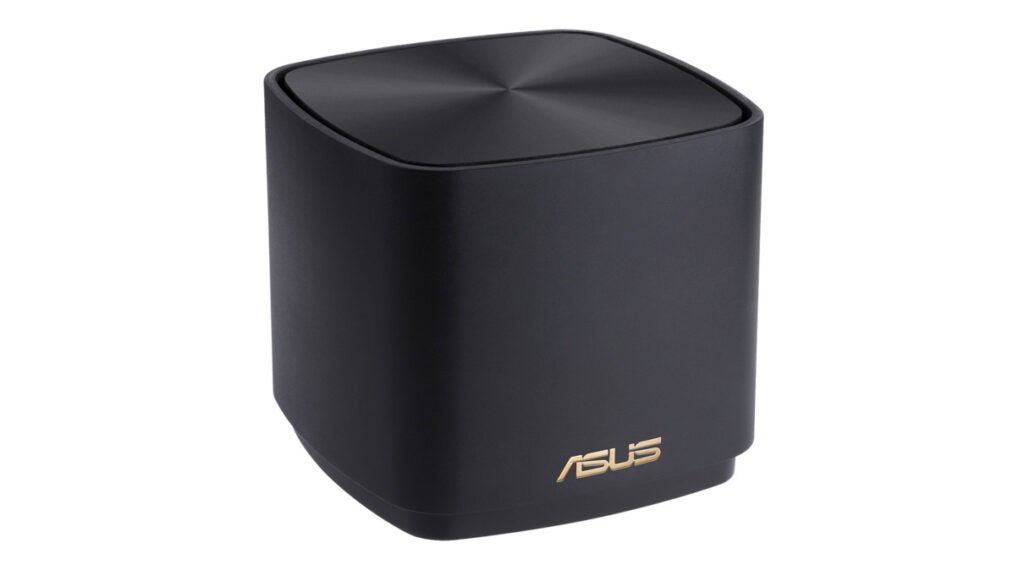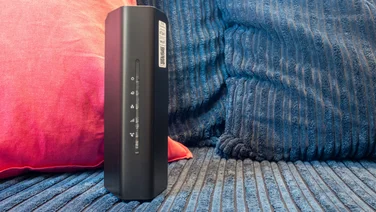To help us provide you with free impartial advice, we may earn a commission if you buy through links on our site. Learn more

- Fast, consistent download performance
- Tremendous range of features and configuration options
- App and web management
- Doesn’t match top speeds of other meshes
- Physical design feels a little cheap
We’ve seen some chunky mesh systems from Asus in the past but the Asus ZenWiFi XD5 is a small-scale affair. Its little cubic stations are similar in size and appearance to the low-cost D-Link M15 Eagle Pro AI AX1500 mesh.
t’s a more powerful system however, claiming twice the performance on both the 2.4GHz and 5GHz network bands, and costing £66 more. It also benefits from a high-end feature set, including VPN support, native parental controls and network security at no extra cost.
Naturally, for the price, there are some compromises. It’s a dual-band system, and has no support for Wi-Fi 6E. When the going gets tough it won’t match the massive throughput of something like the TP-Link Deco XE75. Even so, it’s absolutely fast enough for typical streaming, gaming and home-working duties, making it a great choice for anyone seeking solid, consistent whole-home wireless coverage.
Asus ZenWiFi XD5 review: Price and competition
At the time of writing, the two-node Asus ZenWiFi XD5 pack cost £168 on Amazon. That’s very reasonable but it isn’t the cheapest mesh we’ve tested. The D-Link M15 Eagle Pro AI AX1500 currently costs £146 for two stations, while a pair of Mercusys Halo H80X units will cost you £162. The Huawei Mesh 3 gives you three units for £179.
There are reasons to pay the extra, however. The XD5 has a more versatile and wide-ranging feature set than any of those rivals and, as we’ll see below, it’s at least in the same performance league.

If you’ve more money to spend, you might consider stepping up to a tri-band system, which can deliver better performance when multiple devices are all accessing the network at once. The extra radio means a jump in price, though. The Huawei Mesh 7 costs £330, while the two-unit variant of the Netgear Orbi RBK763S comes in at £340. The Google Nest Wifi Pro and the aforementioned TP-Link Deco XE75 are even pricier at £380 and £483 but those systems come with three nodes as standard and Wi-Fi 6E support.
At the top of the tree, Netgear’s Orbi RBK863 and Orbi RBKE963 systems offer excellent performance but the prices are out of most people’s reach. You’ll pay £800 for a pair of RBK863 units, or £1,200 for the 6E-enabled RBKE963 twin-pack.READ NEXT: The best mesh Wi-Fi systems to buy
Asus ZenWiFi XD5 review: Design and features
The ZenWiFi XD5 units have a pleasingly geometric design, with gently rounded corners that bulge to a maximum of 91 x 91mm and a total height of 85mm. You can choose from a white or black plastic finish: either way, the gold Asus logo on the front looks a bit bling, but you may consider that a good thing.
Aside from that, the stations are minimally designed, to the point of looking a little cheap. A multicolour LED at the front shows the status of each unit but it’s set into the recessed base so you can’t see it if you put the XD5 on the floor or on a low shelf. On the plus side, two mounting holes on the underside of each station make it easy to attach the XD5 stations to a wall.
Also on the bottom, you’ll find two gigabit Ethernet sockets, a reset button and a WPS pairing button. It’s a setup that will be fine for most households; I really would have liked a few more LAN connectors but, if need be, you can hook up an external switch with as many ports as you like.

The other thing you’ll see on the bottom is a QR code, which you can scan with the Asus Router mobile app to set up and manage the mesh network. This app is pretty easy to get on with. There are a lot of pages and options to explore but that’s a reflection of the wide range of software features on hand. You can monitor traffic in real time, check the status of each mesh node, apply parental controls for kids’ devices and manage your LAN configuration and wireless settings.
A particular highlight is Asus’ AiProtection feature, which uses technology licensed from Trend Micro to block dangerous content, check your network for security risks and quarantine infected devices. Unlike most other router manufacturers, Asus offers these services for free in perpetuity – something worth bearing in mind if you’re comparing the price of the XD5 to rival meshes.
Another great Asus-only feature is VPN Fusion, which lets you configure up to 16 outbound VPN connections and bind them to individual devices. This makes it a breeze to (say) spoof the location of your smart TV while the rest of your devices go through your regular ISP.
The Asus Router app can be used from anywhere if you choose to enable remote access, but traditionalists can also log into a local browser-based management interface. This offers the same full range of options and settings and, while the layout doesn’t remotely match up to the app, it’ll be instantly familiar to anyone who’s used an Asus router in the past decade. Whichever interface you use, the degree of flexibility and control on offer is unrivalled by any other mesh brand, at any price.
Asus ZenWiFi XD5 review: Performance
The ZenWiFi XD5’s radio specifications rival some of the fastest routers we’ve tested. However, mesh systems sometimes struggle to properly cover the claimed area and the size and design of the antennae are here limited by the compact casing.
To test the XD5’s performance, I set up the system in my own home as recommended, with one node connected to the broadband line in the study and the other at the opposite end of the adjacent bedroom. I then connected an Asustor Drivestor 4 Pro NAS appliance to the primary node, and took a test laptop equipped with a 2×2 Intel AX210 Wi-Fi 6 network card to various rooms in the house, measuring how quickly I was able to upload and download a set of test files to the NAS.
Here are the speeds I saw in megabytes per second, along with results previously obtained from a range of rival meshes – plus two tri-band Netgear Orbi systems, just to provide a bit of context:
| MB/sec | Bathroom download | Bedroom download | Kitchen download | Living room download | Study download |
| Asus ZenWiFi XD5 | 39.3 | 39.4 | 36.4 | 34.9 | 38 |
| D-Link Eagle Pro M15 | 16 | 20.5 | 14.9 | 17.2 | 58.5 |
| Huawei Mesh 3 | 23.6 | 39.9 | 17.1 | 35.3 | 81.4 |
| Mercusys Halo H80X | 37.9 | 42 | 36.8 | 35.5 | 80.2 |
| Netgear Orbi RBK762S | 47.1 | 76.9 | 23.8 | 59.2 | 99.1 |
| Netgear Orbi RBK963E (Wi-Fi 6E) | 72.7 | 100.3 | 79.4 | 77.1 | 117.7 |
| MB/sec | Bathroom upload | Bedroom upload | Kitchen upload | Living room upload | Study upload |
| Asus ZenWiFi XD5 | 15.8 | 17 | 14.9 | 14.4 | 15.9 |
| D-Link Eagle Pro M15 | 7.4 | 7.9 | 9 | 8.4 | 14.8 |
| Huawei Mesh 3 | 15 | 17 | 15 | 18.1 | 27.3 |
| Mercusys Halo H80X | 13.6 | 17.2 | 12.1 | 13.2 | 24.2 |
| Netgear Orbi RBK762S | 20.1 | 22.3 | 20.8 | 21.2 | 28.2 |
| Netgear Orbi RBK963E (Wi-Fi 6E) | 23.5 | 26.3 | 26.3 | 27.6 | 40.8 |
It’s clear that no mesh in the sub-£300 range can match the performance of a high-end tri-band mesh, especially not once you throw Wi-Fi 6E into the mix.
For what it is though the ZenWiFi XD5 does a very creditable job. As I moved around the house, download speeds were astonishingly consistent, never dropping below 34.9MB/sec – equivalent to around 280Mbits/sec, or fast enough to stream eleven 4K HDR movies from Disney Plus at once. For most households it should be fast and stable enough that, once you have the XD5 up and running, you’ll never need to think about performance at all. Power consumption is low too: I measured a draw of 6.2W per node when sitting idle, peaking at 7.9W while transmitting data at full pelt.
The XD5 has only one arguable weakness. As you can see above, most meshes we’ve tested in the past have achieved some very high download rates at close range; by contrast, the Asus never topped 40MB/sec, even when my laptop was sitting right next to the primary node. Still, if you want a really fast same-room connection, that’s what the Ethernet port is for.READ NEXT: The best wireless routers to buy
Asus ZenWiFi XD5 mesh review: Verdict
Asus’ modestly sized ZenWiFi XD5 units punch well above their weight. They deliver remarkably consistent whole-home Wi-Fi coverage, even with just two nodes, and overall performance is among the best we’ve seen at this price range. Admittedly, the XD5 isn’t as fast as other meshes at close range, but it’s fast enough that I sincerely doubt you’ll notice the difference.
Nor is speed the only thing the XD5 has going for it. It’s absolutely packed with management features, giving you masses of control over your network, using your choice of the breezy app interface or the classic web portal. Security, parental controls, VPN support and more are all bundled for free – the only thing you might need to pay for is a third-party VPN provider.
If you’re focused on value then you can get acceptable performance from a cheaper mesh. Conversely, if you demand the maximum speeds then you’ll need to budget for a tri-band mesh. But in terms of all-round value the ZenWiFi XD5 is hard to beat; it has a real high-end feature set for a very reasonable price, and Wi-Fi speeds are fast and consistent enough to satisfy any household.







